Showing 1–16 of 77 results

Hitler A Pictoral History Free Book PDF

Only registered users can download this book.
Please Login/Register first.

Class 12 History Old NCERT Free PDF

Only registered users can download this book.
Please Login/Register first.
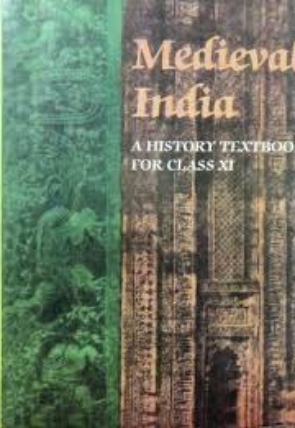
Class 11 History Old NCERT Free PDF

Only registered users can download this book.
Please Login/Register first.
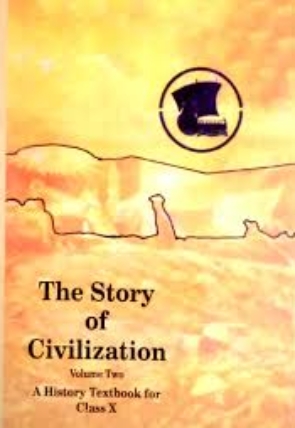
Class 10 History Old NCERT Free PDF

Only registered users can download this book.
Please Login/Register first.

Class 9 History Old NCERT Free PDF

Only registered users can download this book.
Please Login/Register first.
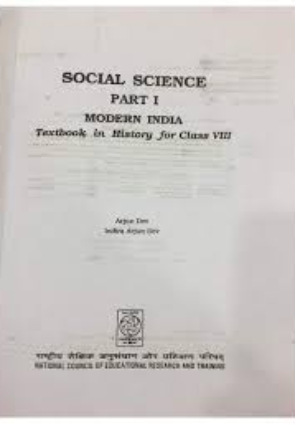
Class 8 History Old NCERT Free PDF

Only registered users can download this book.
Please Login/Register first.
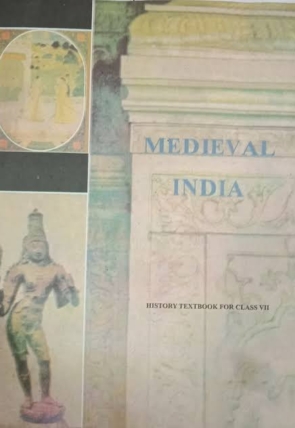
Class 7 History Old NCERT Free PDF

Only registered users can download this book.
Please Login/Register first.
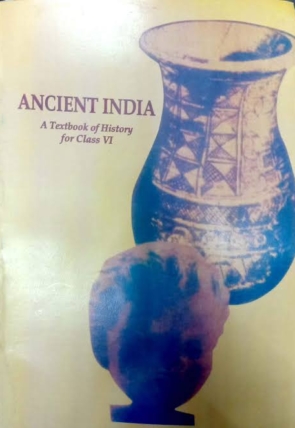
Class 6 History Old NCERT Free PDF

Only registered users can download this book.
Please Login/Register first.
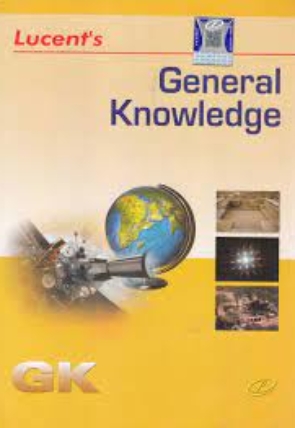
LUCENT GENERAL KNOWLEDGE 2021 EDITION FREE PDF BOOK
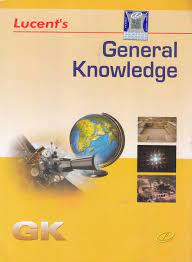
LUCENT GENERAL KNOWLEDGE 2021 EDITION FREE PDF BOOK
Are you searching for the download link for Lucent General Knowledge PDF Book in English?
If yes, then you have reached the RIGHT Place !!
On this page, you will get free download links for the Lucent General Knowledge PDF Latest Edition. You can download this book in English.
This book is one of the best-recommended books for the preparation of competitive examinations like SSC CGL/CHSL/GD, State Govt Exams, SBI, and Other Bank Exams like PO, Clerical and Specialist Officer Exam.
Key Features of Lucent GK PDF Book:
This is one of the recommended books by experts for various competitive examinations like UPSC Civil Services, CDS, NDA, Railway Recruitment Boards (RRBs), SCRA, LIC/GIC/OIC (AAO), CAT, MAT, CLAT, MBA, BBA, MCA, BCA, entrance examinations, etc.
The book is useful to job seekers who want to clear any competitive examination. It keeps the candidate updated with facts that can help him place himself in a better position to appear for these exams.
- It covers all the topics frequently asked in govt. competitive exams ( SSC-CGL, Bank PO exams).
- Language is simple and accurate.
- One of the most economical books.
SPECIFICATIONS :-
| Book |
|
| Author |
|
| Binding |
|
| Publishing Date |
|
| Publisher |
|
| Edition |
|
| Number of Pages |
|
| Language |
|
DESCRIPTION OF THIS BOOK :-
A comprehensive book that covers an exhaustive range of topics, Lucent’s General Knowledge is a reference book for students, ardent quizzers, and just about anyone with a thirst for knowledge.
Some of the most popular competitive exams today feature a paper on general knowledge.
Lucent’s General Knowledge is a handy book for students who aspire to enter various courses through such competitive exams.
An important feature of the book is the range of subjects that it covers.
It combines Social Sciences with Pure Sciences, and the content list includes subjects like Geography, History, Indian Polity, Indian Constitution, General Sciences, and Indian Economy.
The final section of the book covers miscellaneous topics that students need to learn about.
The book is almost like an encyclopedia, taking into account the number of topics covered. The information is provided in an organised manner. Students are sure to find Lucent’s General Knowledge useful, as it provides a starting point for further detailed study into each topic.
The subject matter of this book is comprehensive, thoroughly informative and very useful.
The content of the book has been scientifically devised to cater to the need of the candidates preparing for the competitive exams. The book contains 10 chapters and an appendix. The first chapter describes Indian History through the ages from Ancient period to Modern period with an approach suitable for the examinees of different competitive examinations. Similarly the second chapter throws light on the World History through the ages from Ancient period to Modern period.
The third chapter Geography, fourth chapter Indian Polity and Constitution and the fifth chapter Indian Economy give a vivid description of the subject matters concerned, adorned with lucid language and up-to-date information. The sixth chapter Physics seventh chapter ‘Chemistry’ and eighth chapter Biology are well arranged and updated. The ninth chapter Miscellany is a treasure of conventional general knowledge, which contains varieties of useful information including Firsts, Superlatives, Monuments, International Boundaries, National Emblems/Animals, News Agencies, Map Lines, Parliaments, Signs Symbols, Official books, UNO and World Organisations, International Decades, Years and Weeks, Important Days, India’s World Heritage Sites, Defense of India, Research Centres/Institutes, Musical Instruments and their Exponents, Folk Dances, Famous Places, Crematorium, Nicknames, Awards and Honours, Books and Authors, Games and Sports, National Parks etc.
The tenth chapter Computer gives to the point and up-to-date information of the subject matter. Moreover, Study matter of all the chapters are thoroughly processed, systematically compiled and based on the latest syllabus as well as the question patterns of various contemporary competitive examinations. This book will certainly enhance the level of general knowledge of the students and the candidates of competitive examinations. This book may prove itself trustworthy to cater to the need of its readers.
Only registered users can download this book.
Please Login/Register first.

CLASS 7 HISTORY CHAPTER-TRIBES,NOMADS AND SETTLED COMMUNITIES FREE PDF NOTES
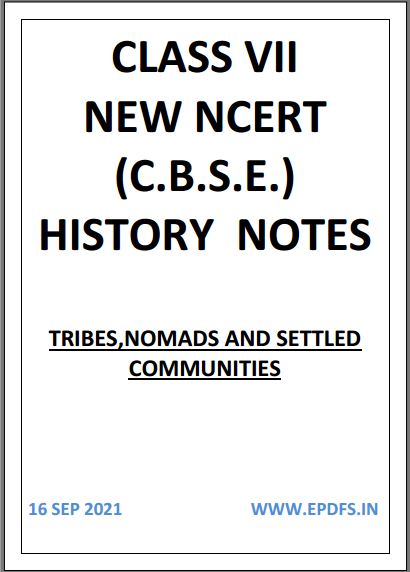
TRIBES,NOMADS AND SETTLED COMMUNITIES FREE PDF NOTES GENERAL BRIEF :-
Tribes,Nomads and Settled Communities Free PDF notes have been made from Class VII Latest History NCERT book. In addition to the content that is been provided by author in the respective book, no additional content has been added in order to make the notes more attractive.
TO WHOM ARE TOWNS,TRADERS AND SETTLED COMMUNITIES FREE PDF NOTES USEFUL ?
Tribes,Nomads and Settled Communities free PDF Notes are helpful to the following students :-
- Those Students who have already gone through their syllabus thoroughly and just looking after the short content to give it a final glance at the time of revision.
- Those Students who don’t want to study the whole NCERT books thoroughly in detail.
- Those Students who are looking after the short notes of NCERT History book classwise and chapterwise.
- Those students who want to give a final touch to NCERT books while preparing for competitive Examination.
WHAT DID TRIBES,NOMADS AND SETTLED COMMUNITIES FREE PDF NOTES CONTAINS ?
- NCERT content’s short notes.
- NCERT content’s DID YOU KNOW.
- Definition from this Chapter.
- Very Important Points from this Chapter.
Several small towns came to be seen in the sub-continent from the 8th century onward. These towns usually had a mandapika or mandi where nearby villagers came to sell their produce. These towns also had market streets called halta or hoot lined with shops.
Hampi was a well-fortified city. No mortar or cementing agent was used in the construction of these walls. The technique followed was to wedge them together by inter-locking.Hampi was the capital of the Vijayanagara Empire in the 14th century.
Chronicles left by Persian and European travellers, particularly the Portuguese, say that Hampi was a prosperous, wealthy and grand city near the Tungabhadra River, with numerous temples, farms and trading markets.
By 1500 CE, Hampi-Vijayanagara was the world’s second-largest medieval-era city after Beijing, and probably India’s richest at that time, attracting traders from Persia and Portugal. The Vijayanagara Empire was defeated by a coalition of Muslim sultanates; its capital was conquered, pillaged and destroyed by sultanate armies in 1565
Only registered users can download this book.
Please Login/Register first.
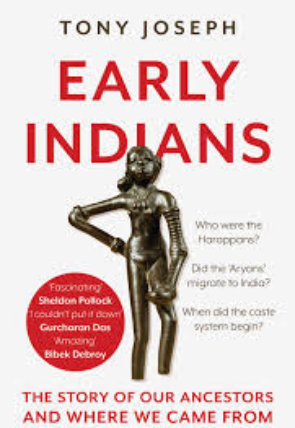
EARLY INDIANS AND THE STORIES OF OUR ANCESTORS AND WHERE WE CAME FROM 2021 EDITIONFREE PDF

Early Indians And The Stories of Our Ancestors and Where We Came From 2021 Edition Free PDF
DESCRIPTION OF BOOK
A 2018 non-fiction book written by Indian journalist Tony Joseph, that focuses on the ancestors of people living today in South Asia. Joseph goes 65,000 years into the past – when anatomically modern humans (Homo sapiens), first made their way from Africa into the Indian subcontinent. The book relies on research findings from six major disciplines – history, archaeology, linguistics, population genetics, philology and epigraphy, and includes path-breaking ancient DNA research of recent years.
The book also relies on the extensive study titled “The Genomic Formation of Central and South Asia”, co-authored by 92 scientists from around the world and co-directed by geneticist David Reich of Harvard Medical School, in which ancient DNA was used. The book was later released in different languages like Tamil, Hindi, Oriya, Telugu, Marathi, Malayalam, Gujarati etc.
WHAT WILL YOU FIND IN THIS BOOK ?
Who are we Indians?
Where did we come from?
Many of us believe our ancestors have lived in South Asia since ‘time immemorial’. But, as it turns out, ‘time immemorial’ may not have been all that long ago.
To tell us the story of our ancestry, journalist Tony Joseph goes 65,000 years into the past – when a band of modern humans, or Homo sapiens, first made their way from Africa into the Indian subcontinent. As Joseph unravels our history using the results of genetics and other research, he takes head-on some of the most controversial and uncomfortable questions of Indian history: Who were the Harappans? Did the ‘Aryans’ really migrate to India? Are North Indians genetically different from South Indians? Are Scheduled Tribes genetically distinct from the rest of the population?
This book relies heavily on path-breaking DNA research of recent years. But it also presents archaeological and linguistic evidence – all in an entertaining and highly readable manner. A hugely significant book, Early Indians authoritatively and bravely puts to rest several ugly debates on the ancestry of modern Indians. It not only shows us how the modern Indian population came to be composed as it is, but also reveals an undeniable and important truth about who we are: we are all migrants. And we are all mixed.
QUESTIONS ANSWERED BY THIS BOOK ?
Who are we Indians ? Where did we come from ? Many of us believe our ancestors have lived in South Asia since ‘time immemorial’. But, as it turns out, ‘time immemorial’ may not have been all that long ago. To tell us the story of our ancestry, journalist Tony Joseph goes 65,000 years into the past—when a band of modern humans, or Homo sapiens, first made their way from Africa into the Indian subcontinent.
Citing recent DNA evidence, he traces the subsequent large migrations of modern humans into India—of agriculturalists from Iran between 7000 and 3000 BCE and pastoralists from the Central Asian Steppe between 2000 and 1000 BCE, among others.
As Joseph unravels our history using the results of genetic and other research, he takes head-on some of the most controversial and uncomfortable questions of Indian history: Who were the Harappans? Did the ‘Aryans’ really migrate to India? Are North Indians genetically different from South Indians? And are the various castes genetically distinct groups?
This book relies heavily on path-breaking DNA research of recent years. But it also presents earlier archaeological and linguistic evidence—all in an entertaining and highly readable manner. A hugely significant book, Ancient Indians authoritatively and bravely puts to rest several ugly debates on the ancestry of modern Indians. It not only shows us how the modern Indian population came to be composed as it is, but also reveals an undeniable and important truth about who we are: we are all migrants. And we are all mixed.
Only registered users can download this book.
Please Login/Register first.

INCREDIBLE HISTORY OF INDIA’S GEOGRAPHY 2021 EDITION BOOK FREE PDF

INCREDIBLE HISTORY OF INDIA’S GEOGRAPHY 2021 EDITION BOOK FREE PDF
DESCRIPTION OF BOOK :-
Maps and mountains, lions and tigers, rivers and oceans-all sorts of things you didn’t know about India’s geography
Could you be related to a blond Lithuanian? What if ostriches once roamed in India? Did you know that India is the only country that has both lions and tigers? Who found out how tall Mt Everest is?
If you’ve ever wanted to know the answers to questions like these, this is the book for you. In here you will discover various things you never expected, such as the fact that we still greet each other like the Harappans did or that people used to think India was full of one-eyed giants. And sneakily you’ll also know more about India’s history and geography by the end of it. Full of quirky pictures and crazy trivia, this book takes you on a fantastic journey through the incredible history of India’s geography.
Could you be related to a blonde Lithuanian? Did you know that India is the only country that has both lions and tigers? Who found out how tall Mt Everest is? If you’ve ever wanted to know the answers to questions like these, this is the book for you.
In here you will find various things you never expected, such as the fact that we still greet each other like the Harappans did and that people used to think India was full of one-eyed giants. And, sneakily, you’ll also know more about India’s history and geography by the end of it. Full of quirky pictures and crazy trivia, this book takes you on a fantastic journey through the incredible history of India’s geography.
The Incredible History of India’s Geography by Sanjeev Sanyal with Sowmya Rajendran, published by Puffin, is one of those magical books which manages to convert historical facts and figures into an interesting read with almost a story like feel to it.
The book explores the journey of the making of India from the ancient times to the current states wedding history with the geographical boundaries of India. The book tells us how ccivilizations flourished and died in India, how different kings invaded to conquer India, what kind of trade routes exist
Only registered users can download this book.
Please Login/Register first.
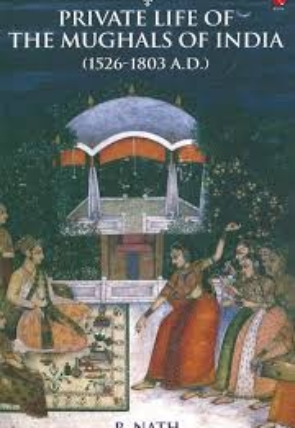
PRIVATE LIFE OF THE MUGHALS OF INDIA 2021 EDITION FREE BOOK PDF

PRIVATE LIFE OF THE MUGHALS OF INDIA 2021 EDITION FREE BOOK PDF
DESCRIPTION OF THIS BOOK :-
The opulent, sometimes scandalous, private lives of the Mughals of India is brought to life in this book. The text covers various aspects of their lifestyles, such as their food and drinks; clothes and ornaments; perfumes and incense; addictions and intoxicants; amusements and pastimes; rituals of circumcision; marriage and harem life. This well-written book with colour illustrations and photographs will be a delight to the lay reader as well as the serious scholar.
Titled as it is, the book deals with the little known, but much scandalized, private life of the Mughals who ruled from 1526, practically to 1803 when the British captured Delhi and Agra, their nerve-centres, from them. This included the period of the reign of three great Mughals, viz. Akbar (1556-1605), Jahangir (1505-27) and Shah Jehan (1628-58), of little more than a century.
They possessed not only fabulous wealth, but also the vision to found a culture-state, in the real sense of the term. Planting it in the soil as naturally as a banyan tree, they institutionalized their life, as much as their government. The former, almost completely shrouded in mystery, offers one of the most interesting aspects of medieval Indian history and culture.
Unfortunately, the official record of their day to day living which was scrupulously maintained has been lost to us.
It has been generally believed that the contemporary Persian chroniclers, living under the court patronage as they did, have blacked out this aspect of their history. Consequently, the modern historians, who have ventured to write on this subject, i. e. Mughal harem life, have almost entirely depended and drew on accounts of foreign travellers. These European travellers visited the Mughal empire contemporarily and some of them were received by the Great Mughals. But they had limitations of language, culture and accessibility to correct information. They viewed the things from the point of view of European civilization and were easily tempted to misinterpret, exaggerate and scandalize. Their narratives on Mughal life have, this, come up to be a strange mixture of a tiny fact with a mountain of fiction. Our historians who, unfortunately relied on their travelogues, have also erred in a large measure and have tremendously contributed to the misunderstanding and misrepresentation of the Mughal lifestyle. It has been unduly romanticized.
Truly, the Persian chroniclers were either prevented from knowing what happened within the four walls of the Mughal harem owing to strict protocol and Purdah, or even when they had access to this knowledge, they did not have the courage to write on this sensitive subject. The Mughal life, consequently, remained a closely guarded secret.
However, the human nature being what it is, these contemporary intellectuals’ sense of wonder led them to leave clever references to their private life in a word or two, casually, in historical narratives, and one has just to read between the lines. A lifetime’s rapport with these sources is needed to unravel these mysteries and, towards the end of it, one is simply amazed to see that there is probably nothing which was not known and which has not been recorded.
Thus, for example, when the historian Badaoni stated, on the eve of Akbar’s marriage with the princess of Jaisalmer, that she ‘obtained eternal glory by entering the female apartments’, he artfully recorded that the Mughals did not practice divorce, or separation even by death, and they married for ‘eternity’, which is how the institution of Sohagpura (The House of Eternal matrimony) came into being. One has just to live up with them to be able to write an authentic history on this abstract subject.
Thus does it cover such aspects of their living as food and drinks; clothes and ornaments; perfumes and incenses; addictions and intoxicants; amusement and pastimes; floor-coverings, furniture and lighting; and, of course, their sex life to which a few chapter have been devoted. How the Mughal king managed to keep a few hundred young and beautiful women attached to his bed is as enlightening a study as it is interesting.
Though based on research, it is written without its jargon, is a simple, readable form, for the general reader.
Only registered users can download this book.
Please Login/Register first.
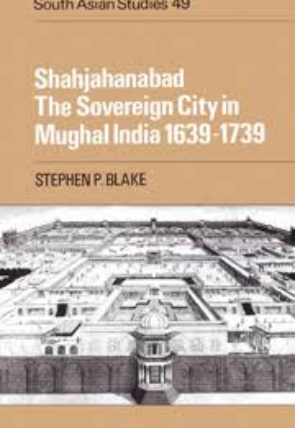
SHAHJAHANABAD THE SOVEREIGN CITY IN MUGHAL INDIA 1991 FREE PDF BOOK

SHAHJAHANABAD : THE SOVEREIGN CITY IN MUGHAL INDIA
DESCRIPTION OF THIS BOOK :-
From 1400 to 1750, Asian capital cities were often ruled in such a way that they became symbols of the power and influence their emperors extended over their states at large. These ‘sovereign cities’ became the empire in miniature. Shahjahanabad is the first study of a pre-modern Indian city (Old Delhi) as a sovereign city. Stephen Blake explores the way in which the emperors’ and nobles’ palaces and mansions dominated the landscape; how cultural life revolved around that of the emperors and their families; and how the households of the great men also dominated the urban economy and controlled a large percentage of state revenue. This study thus illuminates how Asian capitals were not the great amorphous agglomerations described by Marx and Weber. Instead they were urban communities with their own distinctive style and character, dependent on a particular kind of state organization.
Old Delhi or Purani Dilli is an area part of the greater city of Delhi, India. It was founded as a walled city named Shahjahanabad in 1639, when Shah Jahan (the Mughal emperor at the time) decided to shift the Mughal capital from Agra. The construction of the city was completed in 1648, and it remained the capital of the Mughal Empire until its fall in 1857, when the British Raj took over as paramount power in India. It was once filled with mansions of nobles and members of the royal court, along with elegant mosques and gardens.
It serves as the symbolic heart of metropolitan Delhi and is known for its bazaars, street food, shopping locations and its Islamic architecture; Jama Masjid being the most notable example, standing tall in the midst of the old city. Only a few havelis are left and maintained.
The site of Shahjahanabad is north of earlier settlements of Delhi. Its southern part overlaps some of the area that was settled by the Tughlaqs in the 14th century when it was the seat of Delhi Sultanate. The sultanates ruled from Delhi between 1206 and 1526, when the last was replaced by the Mughal dynasty. The five dynasties were the Mamluk dynasty (1206–90), the Khalji dynasty (1290–1320), the Tughlaq dynasty (1320–1414), the Sayyid dynasty (1414–51), Lodi dynasty (1451–1526) and the Suri dynasty (1540-1556)
Delhi remained an important place for the Mughals, who built palaces and forts. Most importantly, Shah Jahan had the walled city built from 1638 to 1649, containing the Lal Qila and the Chandni Chowk. Delhi was one of the original twelve subahs (imperial Mughal provinces), renamed Shahjahanabad in 1648, bordering Awadh, Agra, Ajmer, Multan and Lahore subahs. Daryaganj had the original cantonment of Delhi, after 1803, where a native regiment of Delhi garrison was stationed, which was later shifted to Ridge area. East of Daryaganj was Raj ghat Gate of the walled city, opening at Raj Ghat on Yamuna River. The first wholesale market of Old Delhi opened as the hardware market in Chawri Bazaar in 1840, the next wholesale market was that of dry fruits, spices and herbs at Khari Baoli, opening in 1850. The Phool Mandi (Flower Market) of Daryaganj was established in 1869, and even today, despite serving a small geographical area, it is of great importance due to dense population.
After the fall of the Mughal Empire post 1857 revolt, the British Raj shifted the capital of British controlled territories in India to a less volatile city, Calcutta in Bengal, where it remained until 1911. After the announcement of the change, the British developed Lutyens’ Delhi (in modern New Delhi) just south-west of Shahjahanabad.
At this point, the older city started being called Old Delhi, as New Delhi became the seat of a national government. It was formally inaugurated as such in 1931.
Only registered users can download this book.
Please Login/Register first.
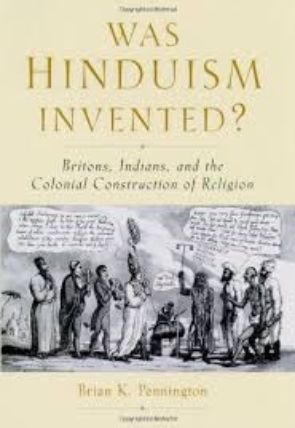
WAS HINDUISM INVENTED FREE PDF BOOK 2021 EDITION

WAS HINDUISM INVENTED FREE PDF BOOK
Drawing on a large body of previously untapped literature, including documents from the Church Missionary Society and Bengali newspapers, Brian Pennington offers a fascinating portrait of the process by which “Hinduism” came into being. He argues against the common idea that the modern construction of religion in colonial India was simply a fabrication of Western Orientalists and missionaries. Rather, he says, it involved the active agency and engagement of Indian authors as well, who interacted, argued, and responded to British authors over key religious issues such as image-worship, sati, tolerance, and conversion.
Drawing on a large body of previously untapped literature, including documents from the Church Missionary Society and Bengali newspapers, Brian Pennington offers a fascinating portrait of the process by which “Hinduism” came into being. He argues against the common idea that the modern construction of religion in colonial India was simply a fabrication of Western Orientalists and missionaries. Rather, he says, it involved the active agency and engagement of Indian authors as well, who interacted, argued, and responded to British authors over key religious issues such as image-worship, sati, tolerance, and conversion.
HINDUISM :-
Hinduism is an Indian religion and dharma, or way of life. It is the world’s third-largest religion, with over 1.2 billion followers, or 15–16% of the global population, known as Hindus. The word Hindu is an exonym, and while Hinduism has been called the oldest religion in the world, many practitioners refer to their religion as Sanātana Dharma (Sanskrit: सनातन धर्म, lit. ”the Eternal Dharma”), which refers to the idea that its origins lie beyond human history, as revealed in the Hindu texts. Another, though less fitting, self-designation is Vaidika dharma, the ‘dharma related to the Vedas.
Hinduism is a diverse system of thought marked by a range of philosophies and shared concepts, rituals, cosmological systems, pilgrimage sites, and shared textual sources that discuss theology, metaphysics, mythology, Vedic yajna, yoga, agamic rituals, and temple building, among other topics. Prominent themes in Hindu beliefs include the four Puruṣārthas, the proper goals or aims of human life; namely, dharma (ethics/duties), artha (prosperity/work), kama (desires/passions) and moksha (liberation/freedom from the passions and the cycle of death and rebirth), as well as karma (action, intent and consequences) and saṃsāra (cycle of death and rebirth). Hinduism prescribes the eternal duties, such as honesty, refraining from injuring living beings (Ahiṃsā), patience, forbearance, self-restraint, virtue, and compassion, among others. Hindu practices include rituals such as puja (worship) and recitations, japa, meditation (dhyāna), family-oriented rites of passage, annual festivals, and occasional pilgrimages. Along with the practice of various yogas, some Hindus leave their social world and material possessions and engage in lifelong Sannyasa (monasticism) in order to achieve moksha.
Hindu texts are classified into Śruti (“heard”) and Smṛti (“remembered”), the major scriptures of which are the Vedas, the Upanishads, the Purānas, the Mahābhārata, the Rāmāyana, and the Āgamas. There are six āstika schools of Hindu philosophy, who recognise the authority of the Vedas, namely Sānkhya, Yoga, Nyāya, Vaisheshika, Mimāmsā and Vedānta. While the Puranic chronology presents a genealogy of thousands of years, starting with the Vedic rishis, scholars regard Hinduism as a fusion[note 6] or synthesis of Brahmanical orthopraxy with various Indian cultures, having diverse roots and no specific founder. This Hindu synthesis emerged after the Vedic period, between c. 500–200 BCE and c. 300 CE, in the period of the Second Urbanisation and the early classical period of Hinduism, when the Epics and the first Purānas were composed. It flourished in the medieval period, with the decline of Buddhism in India.
Currently, the four largest denominations of Hinduism are Vaishnavism, Shaivism, Shaktism, and Smartism. Sources of authority and eternal truths in the Hindu texts play an important role, but there is also a strong Hindu tradition of questioning authority in order to deepen the understanding of these truths and to further develop the tradition. Hinduism is the most widely professed faith in India, Nepal and Mauritius. Significant numbers of Hindu communities are found in Southeast Asia including in Bali, Indonesia, the Caribbean, North America, Europe, Oceania, Africa, and other regions.
Only registered users can download this book.
Please Login/Register first.
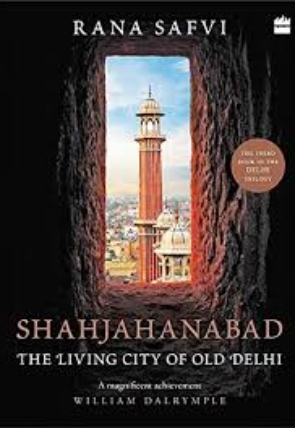
SHAHJAHANABAD THE LIVING CITY OF OLD DELHI 2021 EDITION FREE BOOK PDF

SHAHJAHANABAD THE LIVING CITY OF OLD DELHI 2021 FREE PDF
SHAHJAHANABAD : THE LIVING CITY OF OLD DELHI :-
SHAHJAHANABAD : THE LIVING CITY OF OLD DELHI.What is today the overcrowded, neglected city of Old Delhi was once the magnificent capital of the Mughal Empire. At its heart was the spectacular Qila-e-Mubarak, now known as the Red Fort. Commissioned by Emperor Shah Jahan in 1639, the beautiful city of Shahjahanabad was built around the spectacular Qila-e-Mubarak (Red Fort), on the banks of the Yamuna.
Almost a decade later, in 1648, Shah Jahan entered through the river gate and celebrated the completion of this ‘paradise on earth’ filled with gardens, palaces, water bodies, mosques and temples. About two hundred years later, the last Mughal emperor, Bahadur Shah Zafar, left the fort by the same gate after the failed Mutiny against the British in 1857.
Subsequently, both the fort and the city fared badly, as they faced the wrath of the British.The final instalment in Rana Safvi’s informative, illustrated series of books on Delhi, Shahjahanabad: The Living City of Old Delhi describes the magnificence of the fort and the city through its buildings that are a living monument to the grandeur and strife of the past.
SHAHJAHANABAD :-
The site of Shahjahanabad is north of earlier settlements of Delhi. Its southern part overlaps some of the area that was settled by the Tughlaqs in the 14th century when it was the seat of Delhi Sultanate.
The sultanates ruled from Delhi between 1206 and 1526, when the last was replaced by the Mughal dynasty. The five dynasties were the Mamluk dynasty (1206–90), the Khalji dynasty (1290–1320), the Tughlaq dynasty (1320–1414), the Sayyid dynasty (1414–51), Lodi dynasty (1451–1526) and the Suri dynasty (1540-1556)
Delhi remained an important place for the Mughals, who built palaces and forts. Most importantly, Shah Jahan had the walled city built from 1638 to 1649, containing the Lal Qila and the Chandni Chowk.
Delhi was one of the original twelve subahs (imperial Mughal provinces), renamed Shahjahanabad in 1648, bordering Awadh, Agra, Ajmer, Multan and Lahore subahs. Daryaganj had the original cantonment of Delhi, after 1803, where a native regiment of Delhi garrison was stationed, which was later shifted to Ridge area. East of Daryaganj was Raj ghat Gate of the walled city, opening at Raj Ghat on Yamuna River.
The first wholesale market of Old Delhi opened as the hardware market in Chawri Bazaar in 1840, the next wholesale market was that of dry fruits, spices and herbs at Khari Baoli, opening in 1850. The Phool Mandi (Flower Market) of Daryaganj was established in 1869, and even today, despite serving a small geographical area, it is of great importance due to dense population.
After the fall of the Mughal Empire post 1857 revolt, the British Raj shifted the capital of British controlled territories in India to a less volatile city, Calcutta in Bengal, where it remained until 1911. After the announcement of the change, the British developed Lutyens’ Delhi (in modern New Delhi) just south-west of Shahjahanabad. At this point, the older city started being called Old Delhi, as New Delhi became the seat of a national government. It was formally inaugurated as such in 1931.
It is approximately shaped like a quarter cìrcle, with the Red Fort as the focal point. The old city was surrounded by a wall enclosing about 1,500 acres (6.1 km2), with 14 gates:[10]
- Nigambodh Gate: northeast, leading to historic Nigambodh Ghat on the Yamuna River
- Kashmiri Gate: north
- Mori Gate: north
- Kabuli gate: west
- Lahori gate: west close to the Sadar Railway station, Railway Colony, including the tomb of Syed Abdul Rehman Jilani Dehlvi.[11][12]
- Ajmeri Gate: southwest, leading to Ghaziuddin Khan’s Madrassa and Connaught Place, a focal point in New Delhi
- Turkman Gate: southwest, close to some pre-Shahjahan remains which got enclosed within the walls, including the tomb of Shah Turkman Bayabani.
- Delhi Gate: south leading to Feroz Shah Kotla and what was then older habitation of Delhi.
The surrounding walls, 12 feet (3.7 m) wide and 26 feet (7.9 m) tall, originally of mud, were replaced by red stone in 1657. In the Mughal period, the gates were kept locked at night. The walls have now largely disappeared, but most of the gates are still present. The township of old Delhi is still identifiable in a satellite image because of the density of houses.
The Khooni Darwaza, south of Delhi Gate and just outside the walled city, was originally constructed by Sher Shah Suri.
Only registered users can download this book.
Please Login/Register first.